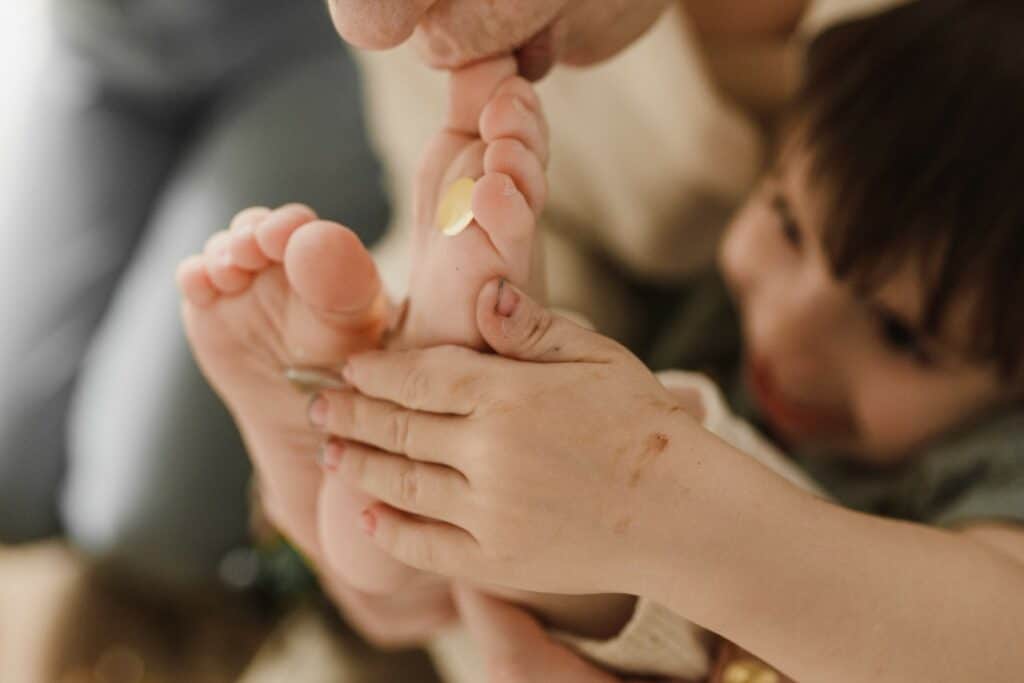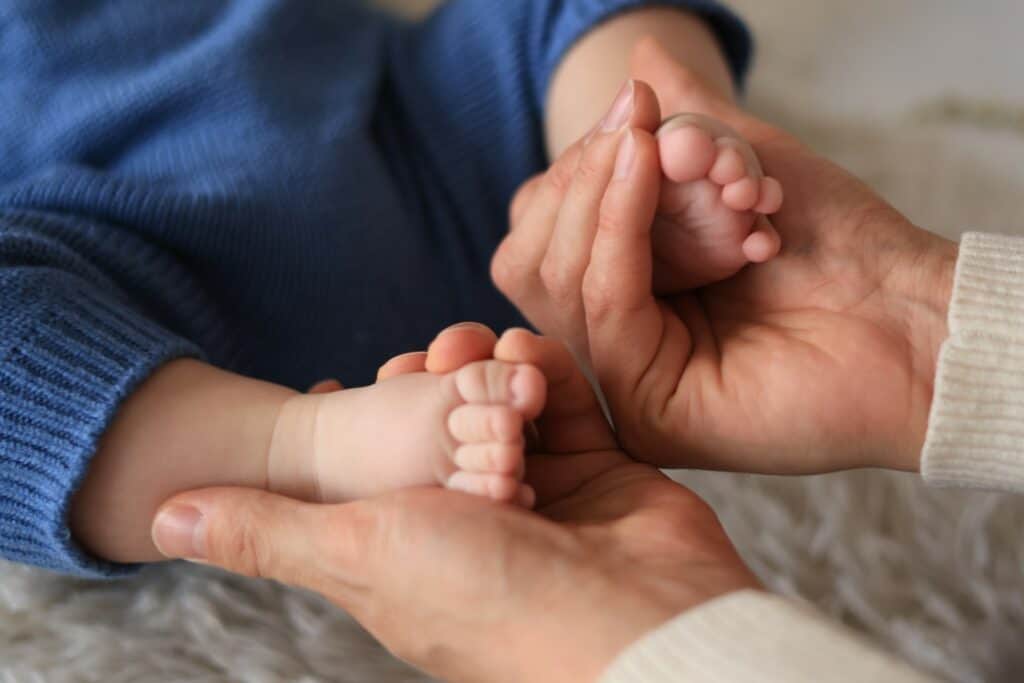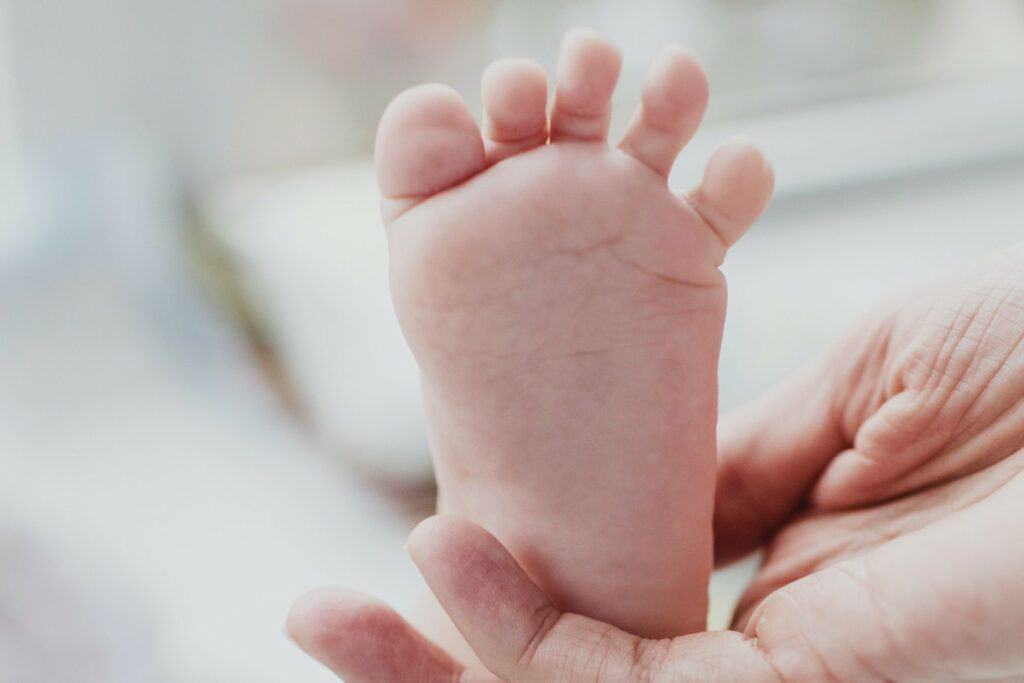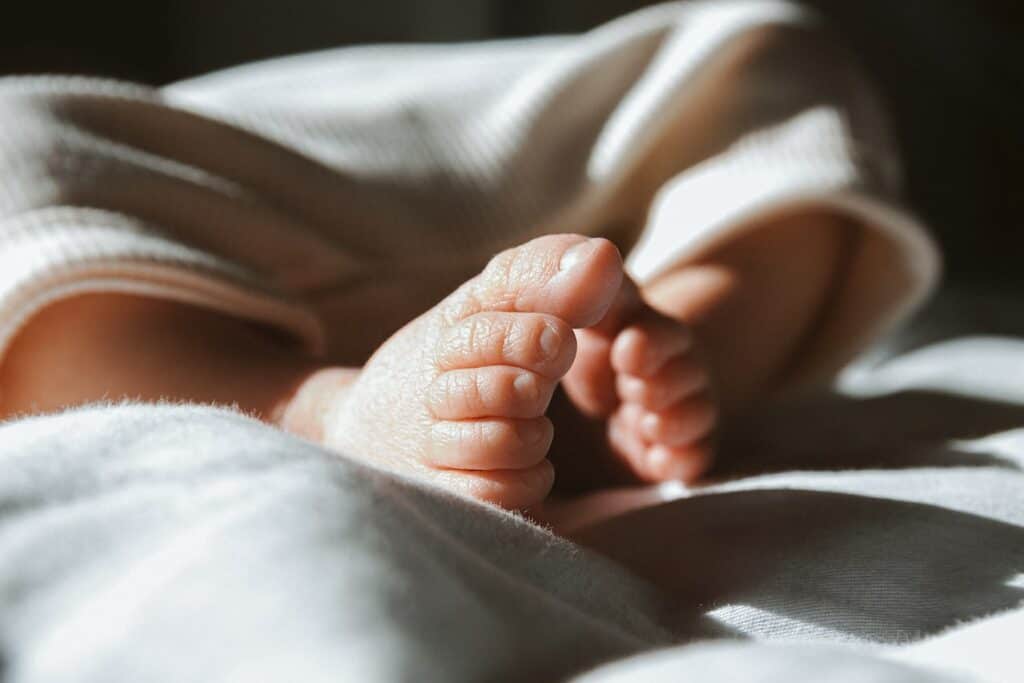Mothers often wonder when can I safely paint my baby’s toenails. While it may seem like a harmless and fun activity, there are certain precautions that should be taken to ensure the safety of the baby. Understanding baby nail care and the potential health risks associated with traditional nail polish is crucial before deciding to paint your baby’s toenails.
Baby nails are delicate and require special care. It is important to keep them clean and trimmed to prevent scratches and infections. Chemical composition of traditional nail polish can be harmful to babies as they are more susceptible to ingesting or absorbing toxins through their skin. Therefore, parents should be cautious when choosing to paint their baby’s toenails and opt for safe nail polish options.
Key Takeaways
- Baby nails require special care and attention.
- Traditional nail polish can be harmful to babies due to their delicate skin and potential for ingestion.
- Parents should choose safe nail polish options and take precautions when painting their baby’s toenails.
Understanding Baby Nail Care
Taking care of a baby’s nails is an important part of their overall health and safety. Although it may seem like a simple task, it requires proper knowledge and technique to avoid injury or infection.

Pediatricians recommend that parents should start trimming their baby’s nails as soon as they are born. Baby nails grow quickly and can easily become long and sharp, which can cause scratches and cuts on their delicate skin. It is important to keep their nails short and smooth to prevent accidental injuries.
When it comes to trimming baby nails, it is important to use proper tools and techniques. Baby nail clippers or scissors specifically designed for infants should be used to avoid accidental cuts or injuries. It is also recommended to trim their nails after a bath when they are relaxed and their nails are softer.
In addition to trimming, it is important to keep baby nails clean to prevent infection. Regularly washing their hands and feet, especially after diaper changes, can help prevent the spread of germs. If a baby’s nails become dirty or infected, it is important to seek medical attention from a doctor or pediatrician.
Overall, taking care of a baby’s nails requires proper knowledge and technique. By following the recommended guidelines and using proper tools, parents can help ensure their baby’s nails are healthy and safe.
Chemical Composition of Traditional Nail Polish
Traditional nail polish is a cosmetic product that is used to decorate and protect nails. It is made up of a combination of chemicals that work together to create a smooth, glossy finish. The chemical composition of nail polish varies between brands, but most contain the following:
- Solvents: These are the chemicals that dissolve the other ingredients in the polish and help it to spread evenly. Common solvents used in nail polish include ethyl acetate, butyl acetate, and isopropyl alcohol.
- Resins: These are the ingredients that give the polish its strength and durability. They form a hard, protective layer over the nail. Common resins used in nail polish include nitrocellulose, which is made from cotton, and acrylic resin.
- Pigments: These are the ingredients that give the polish its color. They are usually made from a combination of organic and inorganic compounds.
- Plasticizers: These are the ingredients that make the polish flexible and prevent it from becoming brittle. Common plasticizers used in nail polish include camphor, which is derived from the camphor tree, and dibutyl phthalate (DBP).
- Other chemicals: Some nail polishes may contain additional chemicals, such as toluene, formaldehyde, and triphenyl phosphate (TPHP). These chemicals are used to improve the performance of the polish, but they can also be harmful to health.
Toluene, for example, is a solvent that can cause headaches, dizziness, and nausea if inhaled in large quantities. Formaldehyde is a preservative that can cause skin irritation and allergic reactions. TPHP is a plasticizer that has been linked to hormone disruption and reproductive problems.
In recent years, many nail polish manufacturers have started to produce “5-free” or “10-free” formulas that do not contain harmful chemicals like toluene, formaldehyde, DBP, and TPHP. These formulas are generally considered to be safer for both the user and the environment.
Potential Health Risks
When it comes to painting a baby’s toenails, there are potential health risks that parents should be aware of. While it may seem harmless, it’s important to understand the potential dangers that could arise.

Harmful Chemicals
Most nail polishes contain harmful chemicals such as formaldehyde, toluene, and phthalates. These chemicals can be absorbed through the skin and can potentially cause harm to the body. Formaldehyde, for example, is a known carcinogen and can cause upper respiratory issues if inhaled.
Skin Irritation and Allergic Reactions
Babies have delicate skin, and nail polish can cause skin irritation and allergic reactions. Some babies may be allergic to the chemicals in nail polish, which can cause itching, redness, and swelling.
Nail Polish Poisoning
Ingesting nail polish can be extremely dangerous and can lead to nail polish poisoning. Symptoms of nail polish poisoning include nausea, vomiting, headache, dizziness, and even seizures. If a baby ingests nail polish, it’s important to seek medical attention immediately.
Endocrine Disruptors
Some nail polishes contain endocrine disruptors, which can interfere with the body’s hormonal system. These chemicals can potentially cause developmental issues and other health problems.
Toxins
Certain nail polishes may contain toxins such as lead and mercury. These toxins can cause serious health problems, especially in babies and young children.
Overall, while painting a baby’s toenails may seem harmless, it’s important to understand the potential health risks involved. Parents should always read the labels on nail polishes and choose products that are free of harmful chemicals and toxins. Additionally, it’s important to keep nail polish out of reach of children and to seek medical attention immediately if a baby ingests nail polish.
Safe Nail Polish Options
When it comes to painting your baby’s toenails, safety should always be a top priority. Fortunately, there are several safe nail polish options available that you can use without worrying about exposing your baby to harmful chemicals.
One popular option is Piggy Paint, a non-toxic, water-based nail polish that is free of harsh chemicals. This brand offers a wide range of colors that are perfect for little ones, and their polishes are easy to apply and quick to dry.
Another great option is Karma Organic Natural Nail Polish, which is made from natural ingredients and is free of harmful chemicals like formaldehyde, toluene, and phthalates. This brand offers a variety of colors that are perfect for children, and their polishes are long-lasting and chip-resistant.
Hopscotch Kids is another brand that offers non-toxic, water-based nail polishes that are safe for children. Their polishes are free of harsh chemicals like formaldehyde, toluene, and phthalates, and they come in a variety of fun colors that kids will love.
Townley Girl is a brand that offers safer polish options for children, including water-based nail polishes that are free of harsh chemicals. Their polishes come in a variety of colors and are easy to apply, making them a great option for parents who want to paint their baby’s toenails at home.
Overall, there are several safe nail polish options available for parents who want to paint their baby’s toenails. By choosing non-toxic, water-based, and chemical-free polishes, you can ensure that your little one stays safe while still enjoying a fun and colorful manicure.
When to Paint Baby’s Toenails
Many parents may wonder when it is safe to start painting their baby’s toenails. While it may seem like a harmless and fun activity, there are some important considerations to keep in mind.

Age is an important factor to consider when deciding whether or not to paint your baby’s toenails. Pediatricians generally recommend waiting until a baby is at least six months old before applying any type of nail polish. This is because newborns and young infants have very delicate skin, and their nails are still soft and pliable.
Once a baby reaches six months of age, their nails will have hardened and their skin will be less sensitive. At this point, it may be safe to start painting their toenails. However, it is important to choose a non-toxic and hypoallergenic nail polish specifically designed for babies and toddlers. These types of polishes are free of harmful chemicals and are less likely to cause an allergic reaction.
When it comes to toddlers, it is generally safe to continue painting their toenails as long as the nail polish is non-toxic and applied properly. However, it is important to monitor your child’s reaction to the nail polish and discontinue use if any signs of irritation or allergic reaction occur.
In summary, parents should wait until their baby is at least six months old before considering painting their toenails. Non-toxic and hypoallergenic nail polish should be used to minimize the risk of any adverse reactions. Parents should also monitor their child’s reaction to the nail polish and discontinue use if any signs of irritation or allergic reaction occur.
Precautions When Painting Baby’s Toenails
When it comes to painting a baby’s toenails, parents should be aware of the precautions that need to be taken to ensure the safety of their child. Here are some important points to keep in mind:
Fumes: It is important to avoid exposing the baby to any harmful fumes that may arise from the nail polish. Parents should ensure that the room is well-ventilated and avoid painting the nails in enclosed spaces.
Skin: The baby’s skin is delicate and sensitive, so it is important to avoid getting any nail polish on their skin. Parents should use a small brush to carefully apply the nail polish to the toenails, being careful not to touch the surrounding skin.
Breathe: Babies have a tendency to put their toes in their mouth, so parents should ensure that the nail polish is completely dry before the baby is allowed to touch their toes. In addition, parents should avoid painting the nails too frequently, as this can lead to the baby inhaling the fumes.
Ingestion: If the baby does happen to ingest any nail polish, parents should seek medical attention immediately. It is important to keep the nail polish out of reach of the baby, and to store it in a safe place.
In summary, painting a baby’s toenails can be a fun and cute activity, but parents should be aware of the precautions that need to be taken to ensure the safety of their child. By following these guidelines, parents can safely paint their baby’s toenails without any risk of harm.
Can Babies Go to Nail Salons?
Parents often wonder if it is safe to take their babies to nail salons. While it may seem harmless to bring a baby to a salon, there are some factors to consider.

Firstly, it is important to note that most nail salons use chemicals and tools that can be harmful to babies. For example, the fumes from nail polish and nail polish remover can be toxic, and the tools used for pedicures can be sharp and pose a risk to a baby’s delicate skin.
In addition, babies are more susceptible to infections, and nail salons can be a breeding ground for bacteria and viruses. It is important to ensure that the salon you choose follows proper hygiene practices, such as sterilizing their tools and equipment and using fresh towels for each customer.
While some salons offer baby-friendly services, such as non-toxic nail polish and gentle pedicures, it is still important to exercise caution. Parents should always supervise their baby during the appointment and ensure that the salon is taking all necessary precautions to protect their child.
In conclusion, while it is possible for babies to go to nail salons, it is important to carefully consider the risks and take necessary precautions. Parents should only choose reputable salons that follow proper hygiene practices and supervise their baby at all times during the appointment.
Treatment for Accidental Ingestion or Exposure
Accidental ingestion or exposure to nail polish or other nail products can happen, especially with babies and young children. If this happens, it is important to take immediate action. Here are some steps to follow:
- Treat the symptoms: If the child shows any symptoms of poisoning, such as vomiting, difficulty breathing, or loss of consciousness, seek medical attention immediately. If there are no symptoms, monitor the child closely for any changes in behavior or health.
- Identify the product: Look for the product label or packaging to identify the ingredients. If the product is toxic or contains hazardous chemicals, call poison control or seek medical attention immediately.
- Contact the manufacturer: If the product is non-toxic, contact the manufacturer to ask for specific instructions on how to remove the product from the child’s skin or nails.
- Remove the product: Use a non-toxic nail polish remover or gentle soap and water to remove the product from the child’s skin or nails. Do not use harsh chemicals or abrasives.
- Prevent future incidents: Store nail products out of reach of children and supervise their use. Teach children not to put their fingers or toes in their mouth.
Remember, prevention is the best course of action. Always read labels and follow instructions carefully when using nail products around children.
Conclusion
In conclusion, painting a baby’s toenails can be a fun and adorable way to accessorize their little feet. However, it is important to consider the potential risks and take necessary precautions before doing so.
Firstly, parents should wait until their baby is at least six months old before painting their toenails. This is because their nails are still developing and may be more sensitive to chemicals found in nail polish.
Secondly, parents should choose a non-toxic and water-based nail polish that is specifically designed for babies. This will minimize the risk of allergic reactions or harmful chemicals being absorbed through their skin.
Lastly, parents should always supervise their baby during the painting process and ensure that the nail polish has fully dried before allowing them to touch their feet or put them in their mouth.
By following these guidelines, parents can safely and confidently paint their baby’s toenails and enjoy this cute and fun activity together.
Frequently Asked Questions
What age is it safe to paint my baby’s toenails?
It is generally recommended to wait until your baby is at least 6 months old before painting their toenails. This is because their nails are still soft and delicate, and their skin is more sensitive. Additionally, it is important to ensure that your baby’s nails are trimmed and clean before applying any nail polish.
Can I use non-toxic nail polish on my baby’s toenails?
Yes, using non-toxic nail polish is safe for your baby’s toenails. Non-toxic nail polish is free of harmful chemicals like formaldehyde, toluene, and phthalates, which can be harmful to your baby’s health. It is important to always read the label and choose a non-toxic nail polish that is specifically designed for babies.
When should I file my baby’s nails for the first time?
It is recommended to file your baby’s nails for the first time when they are about a week old. This is because their nails are soft and flexible, making it easier to shape them without causing any discomfort. It is important to use a soft nail file and file in one direction to avoid causing any damage to their delicate nails.
Is it safe to paint my baby’s toenails?
Yes, it is safe to paint your baby’s toenails as long as you use a non-toxic nail polish and follow the recommended guidelines. It is important to ensure that your baby’s nails are clean and dry before applying any nail polish. Additionally, it is recommended to avoid painting your baby’s toenails too frequently to prevent any potential irritation or damage to their nails.
What are some non-toxic nail polish options for babies?
There are several non-toxic nail polish options available for babies, including Piggy Paint, Suncoat, and Snails. These nail polishes are free of harmful chemicals and are specifically designed for babies and young children.
At what age can I start painting my child’s toenails?
It is generally safe to start painting your child’s toenails when they are around 2 years old. At this age, their nails are stronger and less likely to break or peel. It is important to ensure that you use a non-toxic nail polish and follow the recommended guidelines to prevent any potential harm to your child’s health.

Iesha is a loving mother of 2 beautiful children. She’s an active parent who enjoys indoor and outdoor adventures with her family. Her mission is to share practical and realistic parenting advice to help the parenting community becoming stronger.
